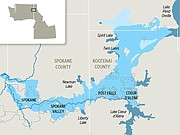Our Gem: County acts to protect ground water
Idaho is the fastest-growing state in the nation, and Kootenai County is the third-fastest growing county in the state. This new growth is mostly occurring over the Rathdrum Prairie Aquifer, where the use of septic systems is common for any development located in the unincorporated county. Increased numbers of septic systems over the aquifer, if not adequately spaced, can significantly deteriorate the aquifer’s water quality.
Why does this matter? The Rathdrum Prairie Aquifer is the sole source of drinking water for most of Kootenai County. Not only has the Idaho Department of Environmental Quality designated this water source as a “sensitive resource aquifer,” the U.S. Environmental Protection Agency has determined that it is part of the greater Spokane Valley-Rathdrum Aquifer, which is the sole source of drinking water for over 600,000 people in Kootenai County, Idaho and Spokane County, Washington. Discharge from septic systems can have high concentrations of minerals, such as chloride and nutrients, such as nitrates. Increasing the density of drainfields over the aquifer escalates the risk of potential contamination.
There is a long history of protecting the water quality of the aquifer. In 1977, Panhandle Health District (PHD) adopted Idaho Administrative Procedure Act (IDAPA) rule 41.01.01.110, which restricts septic density over the Rathdrum Prairie aquifer to one dwelling per five acres. The five-acre septic density rule has significantly preserved the aquifer’s water quality so that it continues to serve as a direct source of water without the need for treatment.
Recently, PHD’s rule-making authority has come into question, and as a result, the IDAPA rule protecting the aquifer is set to expire at the end of this year’s legislative session. In preparation of the expiration of the IDAPA rule, and to ensure continued adequate aquifer water quality, the Kootenai County Board of County Commissioners enacted an emergency ordinance on March 22, 2022, that maintains the same five-acre septic density.
The emergency ordinance amended the minimum lot sizes of the County’s zoning districts to coincide with the boundaries of the aquifer. The full text of the emergency ordinance is available at (https://keepingkootenai). However, the emergency ordinance is not a permanent solution. Under state law, emergency ordinances can only last for 182 calendar days. Consequently, Kootenai County Community Development staff is drafting an amendment to the Land Use and Development Code that will make the five-acre rule a permanent part of the County’s code.
The amendment will be available to the public via the County’s web page and will be reviewed by the County Planning and Zoning Commission at workshops before being scheduled for public hearings in front of the Planning and Zoning Commission and the Board of County Commissioners. These continued efforts to limit septic drainfield densities are critical to protect our county’s source of clean drinking water for many decades to come.
For more information, visit www.kcgov.us/230/Planning or contact David Callahan, director of Kootenai County Development, at dcallahan@kcgov.us.
• • •
The Our Gem Coeur d’Alene Lake Collaborative is a team of committed and passionate professionals working to preserve lake health and protect water quality by promoting community awareness of local water resources through education, outreach and stewardship. Our Gem includes local experts from the University of Idaho Community Water Resource Center, Coeur d’Alene Tribe, Idaho Department of Environmental Quality, Kootenai Environmental Alliance, Kootenai County, Coeur d’Alene Regional Chamber and CDA 2030.



